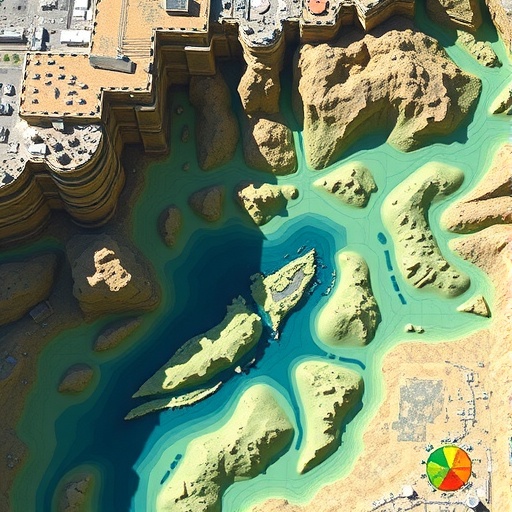A revolutionary approach to hydrological modeling has emerged from the collaborative research conducted by Youssefi, Soltani, Ali, and their team, focusing on the Rhine Basin. This study integrates state-of-the-art fully-coupled hydrological modeling techniques with advanced machine learning algorithms, particularly Random Forest, to enhance the spatial resolution of water storage estimates derived from the Gravity Recovery and Climate Experiment (GRACE) satellite observations. The implications of this research are profound, reflecting a growing need for precise water resource management in the face of climate change and increasing anthropogenic pressures.
In recent years, the importance of accurately monitoring and managing water resources has surged, particularly in regions as vital as the Rhine Basin. This area, with its strategic ecological and economic significance, has experienced significant stress from both natural and human-induced changes. The study’s underlying motivation stems from these challenges, emphasizing the necessity of improved methodologies to monitor water availability and variability effectively. By addressing these needs with enhanced models, the research aims to provide actionable insights for water management authorities.
At the heart of this innovation is the integration of fully-coupled hydrological models. These models simulate the complex interactions within the hydrological cycle, including precipitation, evaporation, and the movement of water through different components of the landscape. By applying these models in conjunction with GRACE data, researchers can derive more accurate representations of water storage changes over time, ultimately allowing for a better understanding of hydrological dynamics within the basin.
The deployment of the Random Forest algorithm represents a significant advancement in processing GRACE observations. Traditionally, extracting useful information from such satellite data has presented numerous challenges due to its coarse spatial resolution. However, by leveraging the power of machine learning, the research team has developed a framework that enhances the clarity and usability of these observations. This transformation enables researchers to pinpoint specific areas of interest, leading to targeted water management strategies that address regional needs.
Furthermore, the study highlights the collaborative nature of contemporary scientific research. By integrating diverse expertise—from hydrologists to data scientists—the research exemplifies how interdisciplinary approaches can yield innovative solutions to complex environmental challenges. The synergy between traditional hydrological modeling techniques and cutting-edge machine learning demonstrates the potential for further advancements in this field.
As the research delves deeper into the implications of these findings, it discusses the potential ramifications for policymakers and water resource managers. With the increasing unpredictability of water availability due to climate change, such accurate modeling becomes crucial. The ability to predict changes in water storage at a finer resolution can significantly enhance the preparedness and responsiveness of water management systems, ultimately contributing to water security in the Rhine Basin and beyond.
In light of the urgency for climate resilience, this research offers critical insights into managing water resources sustainably. As communities grapple with rising demands and dwindling supplies, the enhanced modeling techniques can guide decision-makers in crafting policies that secure long-term water availability. Furthermore, by showcasing a methodology that can be replicated in other basins worldwide, this study extends its impact beyond the Rhine, addressing global water challenges.
The findings from this study are set to reshape our understanding of hydrological variability within the Rhine Basin. As researchers continue to refine these models and techniques, the implications for environmental monitoring and management practices will only deepen. This groundbreaking work serves as a reminder of the interconnectedness of water ecosystems and the necessity for robust models that can respond to the challenges presented by climate change.
The collaboration also provides a framework for future research, suggesting that similar methodologies could be applied in other regions facing comparable water management issues. The blend of hydrological modeling and machine learning may well become a standard approach in the realm of environmental science, paving the way for further innovations that enhance our understanding of resource dynamics.
In conclusion, this integration of fully-coupled hydrological modeling with Random Forest techniques marks a pivotal moment in water resource management. By providing a clearer understanding of water storage dynamics within the Rhine Basin, the research has profound implications not only for local ecosystems but also for global water security initiatives. As the world continues to seek sustainable solutions to environmental challenges, studies like this will play an essential role in shaping effective strategies for the future.
The anticipated outcomes from this research extend into various sectors including agricultural management, urban development, and ecological conservation. With improved models at their disposal, stakeholders can better predict water availability, allowing for efficient allocation and usage plans that mitigate wastage and promote sustainability. The potential economic benefits, coupled with the environmental gains, solidify the relevance of this research in promoting overall societal well-being.
Moving forward, the commitment to ongoing research and refinement of these techniques will be crucial. As our understanding of the complexities of hydrological systems deepens, so too will the methodologies employed to analyze them. The merge of hydrology and machine learning thus represents more than just a technical achievement; it embodies a shift towards a more integrated and effective approach to environmental stewardship.
In closing, the integration of fully-coupled hydrological modeling and Random Forest methods provides an essential leap forward in how we approach water resource management. This research not only stands as a significant contribution to the scientific community but also serves a global reminder of the importance of adapting to and mitigating the impacts of climate change on our most precious resource: water.
Subject of Research: Enhancing spatial resolution of GRACE-observed water storage through integrated modeling.
Article Title: Integrating Fully-Coupled Hydrological Modeling and Random Forest to Enhance Spatial Resolution of GRACE-Observed Water Storage Across the Rhine Basin.
Article References: Youssefi, F., Soltani, S.S., Ali, S. et al. Integrating Fully-Coupled Hydrological Modeling and Random Forest to Enhance Spatial Resolution of GRACE-Observed Water Storage Across the Rhine Basin. Nat Resour Res 34, 2667–2684 (2025). https://doi.org/10.1007/s11053-025-10528-4
Image Credits: AI Generated
DOI: https://doi.org/10.1007/s11053-025-10528-4
Keywords: Hydrological modeling, Random Forest, GRACE satellite, water storage, Rhine Basin, climate change, water resource management, machine learning, environmental monitoring.




